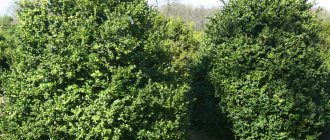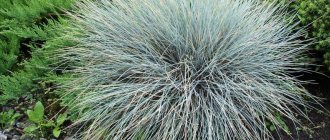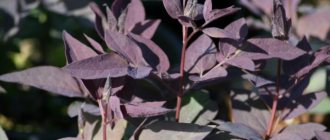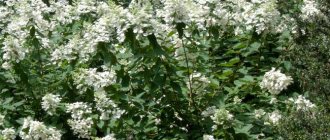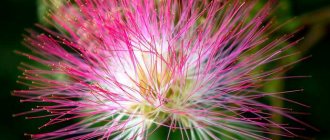Privet grows in the form of small shrubs and trees. The plant can be found in European, Asian, and North African territories. In appearance, privet resembles lilac, which is known to everyone in Russian latitudes. And this is understandable, because privet and lilac are close relatives. Shrub plantings are very well used in landscape design. Privet can very easily take on almost any shape when pruned and shaped; however, an untrimmed shrub does not look very attractive. The evergreen tree is highly popular among landscape designers.
Privet description
This genus of plants includes deciduous and evergreen shrubs and small trees. According to descriptive characteristics, there are more than 50 varieties of privet. The plant is easy to care for and can grow well in a shaded area, which is why privet is so widespread in landscape decoration. In most cases, the tree is used to create hedges.
The leaves of the plant are small. They are leathery on top, with a glossy effect. The leaf is oval-shaped and grows up to 6 cm. Privet can shed its foliage when cold weather sets in, or, conversely, remain evergreen, in this case it all depends on the type of shrub. There is also a mixed type of culture, then the leaves are shed in parts.
The flowers are painted white, the inflorescences are paniculate. When privet blooms, it releases a strong but amazing aroma. After the bush fades, fruit formation occurs. The plant begins to bloom in the first days of June. In warm climates, privet can bloom 7-14 days earlier. Flowering continues for three months. The flowering tree is very attractive with its aromatic qualities, but some varieties have an overly pungent odor.
At the stage of flower formation, privet turns in a special way into a beautiful and attractive tree. In a descriptive description of the plant, its flowers are compared to a snowball that covers the branches to the very top.
The berries are bluish-black in color. The fruits hang on the bush throughout the winter. The popular name for the berries is “wolf berries”. Each fruit contains 1-4 seeds, the berries are round in shape.
The shrub reaches a height of 1.5-3 meters, growth depends on the specific variety. There are dwarf varieties, 0.6-1 m high. Growth is regulated using the pruning procedure. The main advantage of the plant is that it can be shaped as you like; the shape can be spherical, cone-shaped, or pyramidal.
Is privet dangerous?
The fruits and foliage are poisonous and dangerous. Both humans and animals can get poisoned. The berries contain tetroid glycosides, which cause a poisoning reaction, especially if you eat a lot of fruits at once. Moreover, the bark and other fragments of the plant are used for medicinal purposes. However, you should be familiar with the exact recipe and use the drug strictly as prescribed. Parents of small children should not forget about the toxicity of the shrub in order to avoid harm to health from this ornamental tree.
The main signs that a person is poisoned: colic, weakness, diarrhea. Further, you can lose coordination of movements, convulsions are possible. In most cases, death may occur.
Application
Thanks to its dense decorative foliage, privet is excellent for landscaping gardens, creating hedges, and decorating borders. Most species are gas-resistant, insensitive to air pollution, and unpretentious to soil quality. Crowns lend themselves well to shaping haircuts.
Heat-loving dwarf varieties in temperate climates can be grown as container greenhouse crops. Privet bonsai is popular as a houseplant. Winter-hardy species, for example, common ligustrum, can be planted in open ground.
Privet in landscape design
The tree can be found in a large number of photographs with decorated landscapes. The plant is used by professionals and amateurs to decorate areas. There are a great many photos of stamped shrubs and trees in sculpture. Privet looks great when planted alone or when planted in groups. The plant is widely used as hedges. The variety of privet can allow you to choose a bush of a height that would be suitable for the area. This plant is used in topiary and alpine slides. The crop is also widely used to create fences. Such fences can be found almost everywhere.
Plant varieties
A wide variety of privet allows you to choose an individual site decoration that suits you. For those who love evergreen decors, there are varieties for which the foliage does not fall, and even in the winter season the shrub will delight you. Varieties differ in size, crown, length of inflorescences and other characteristics.
Privet "Golden".
This variety is the most popular in the field of landscape decoration. This is a subspecies of “Japanese” or “Oval-leaved” privet. The shrub is semi-evergreen, which means that the leaves are partially shed. The leaves are richly colored, the plant looks decorative even in winter. Grows well in any climate and does not tolerate moist soil. This is a light-loving tree, so it is recommended to choose a well-lit place for it with a minimum amount of shading. Leaves with a glossy effect, oval-shaped, grow up to 6 cm. The edges of the leaves are distinguished by a golden edging.
The bark of the plant is grayish-brown. The fruits are black in color and shiny, and are dangerous to people, as they are poisonous. The variety has good wind tolerance, so there is no need to plant it in windy areas.
Privet "Brilliant".
This variety grows in Chinese, Korean, and Japanese territories. The tree is compact. The outer part of the leaf is shiny, the leaf grows up to 15 cm. The inflorescences reach a length of 18 cm. The plant blooms for 3 months. This type of privet is one of the most frost-resistant species, tolerating frosty temperature conditions down to -15 degrees. However, if the temperature drops further, then it is necessary to provide shelter for the plant during the harsh winter season.
Privet "Motley leaf".
This is a subspecies of "Chinese" privet. A characteristic feature of the variety are elongated leaves, sharp, with fields of golden color. The appearance of flowers occurs in the autumn season. The flowers are painted white with a creamy tone. The plant has a very pleasant aroma when it blooms. The first flowering will occur only three years after planting the shrub. This variety is light-loving; the planting area should be well lit with a minimum amount of shading. The variety quickly gains growth, growing up to 2 m. It is often used to create hedges.
Privet "Japanese".
The variety can be found growing wild in Japanese and Korean territories, hence the name. In Japan, the variety is used to create ikebana. Reaches a height of 4 m. A wild tree can have a height of 8 m, but it is a slow-growing plant. Privet has a compact and dense crown. The plant can easily take on any shape when pruned. The leaves are small and dark green in color. The variety is resistant to cold periods, and therefore the shrub can grow in most Russian territories without problems. The flowers are white, but the aroma is not so pleasant.
Privet "Sinensa".
A small plant native to Chinese territory. This is a type of “Common” privet. In middle Russian latitudes it reaches a height of up to 2 m, but if climatic conditions allow, the growth of the shrub can be up to five meters. The variety is frost-resistant and can withstand short periods of frost down to -30 degrees. If the winter season is very harsh, then it is necessary to provide shelter for the plant.
When decorating landscapes, this variety is used as low hedges, topiary, in a spherical or square shape.
Privet "Argentum".
This variety blooms in the second or third month of summer. The plant reaches a height of 1.5 m. The shrub has good tolerance to diseases and harmful insects, can be pruned, so after it it looks especially decorative. Privet is so named for the color of its leaves, which seem to be dusted with snow. The variety is drought-resistant and lives well without frequent watering. Does not tolerate overly moist soil.
Privet "Atrovirens".
This is a well-known variety of “Common” privet. Flowering occurs from June to July, however, the white flowers emit an overly pungent aroma. The shoots of the plant are vertical. The bush is considered semi-evergreen, reaching 4 m in height. The leaves are glossy, dark green, and in the winter the color changes to purple-brown. In spring, leaves are shed. The berries are black, glossy, and have several seeds. Basically, this shrub is unpretentious, but it cannot always tolerate shaded areas well.
Privet "Molodushka".
This is a deciduous plant with a rounded crown, growing up to 5 m. The branches are thin and curved. The inflorescences are paniculate and grow up to 20 cm in length. The flowers are white and have a pleasant aroma. Flowering occurs later than other varieties, in the last days of summer or in the first days of autumn. The berries are shiny, black-purple in color, and egg-shaped. The shrub does not like to grow on damp, clayey soils. It has poor tolerance to winter seasons with frosty periods, the plant is heat-loving and can tolerate drought. If privet freezes in the winter, it will easily recover in the spring. This is a fast-growing plant that lends itself well to pruning.
Views from photos
There are more than 50 plant species in the common privet genus. They differ in growth duration, shape and types (bushes, trees).
Common privet - native to Russia, Ukraine, China, Japan. In some varieties it can grow up to 4-5 meters. The leaves have an oval shape. Unpretentious to the presence of sunlight. During the flowering period it acquires white flowers. The most cold-resistant type, does not require covering in winter.
The following varieties of common privet have gained popularity:
- Aurea (round-leaved) - does not tolerate cold, has golden foliage. Grows up to one meter in height. Doesn't bloom.
- Ash-leaved maple is a non-flowering shrub, reaching a height of 3-4 meters. Cold resistance is poor.
- Glaucum Albo-marginatum is a non-flowering shrub no more than one meter high. The foliage is emerald green with silver edging.
- Glaucum – bluish foliage. Non-flowering.
- Vicari - has a densely planted crown. Height up to a meter, does not tolerate wind. The foliage has a yellow tint, and in winter it has a burgundy tint. Flowering period is summer.
You can visually familiarize yourself with common privet in the photo below:
Shiny (golden)
Shrub or tree up to 6 meters high. Flowering occurs in summer and lasts about three months. The fruits are similar to currants, small, dark. It takes root in fertile soil, although it tolerates shade well. Often used to create hedges due to its decorative appearance.
Japanese
It is close to brilliant, but grows more slowly and blooms less, but is shade-tolerant. Grows up to 4 meters.
Variegated (Chinese)
Grows up to two meters, suitable for growing hedges. Does not tolerate lack of sun well. Leaves with a golden border, bears white flowers during flowering. It blooms late - after reaching the age of three. With the help of fertilizers you can extend the flowering period.
Qihou
The shrub grows up to two meters, blooms for a short time, up to one and a half to two weeks, in July.
Amurskaya
A shrub that requires shelter for the winter, as it does not tolerate cold well. Fruits in early autumn.
Privet planting and care
To make the plant decorative and, thus, to decorate the area with it for a long time, it is necessary to properly plant privet and properly care for it. It is necessary to select the best planting time and site. The location may depend on the plant variety, but the agrotechnical techniques are almost identical, and there are no big differences in watering and pruning among different varieties. Pruning and shaping are mandatory, otherwise the privet will look sloppy and unkempt.
Planting rules.
When planting a crop, a site is selected and prepared. First, a site is selected. The tree is not afraid of winds; it can grow in a shaded place. The plant is unpretentious to the soil, but it is better not to plant it on acidic, sandy and dry soils, or it is necessary to add fertile mixtures to the soil. The crop should be planted a meter away from nearby plants or buildings.
It is recommended to prepare a soil mixture for planting. It consists of two parts humus, three parts turf soil, one part sand. It is advisable to plant privet in the spring before the buds open. In the autumn season it is also allowed to plant shrubs. The main thing is that it has time to adapt before the onset of the first cold snap.
The planting hole is dug 25 cm deep, its diameter is 65 cm. The depth is determined more accurately by the type of root system. The hole should be slightly larger in depth and diameter compared to the roots. The bottom of the hole is spilled with water, then a drainage layer in the form of crushed stone is laid. The thickness of the drainage should be 20 cm. Nitroammophoska is added to the prepared soil mixture, then a little soil is poured into the hole in the form of a mound. Next, the seedling is installed and the roots are straightened in advance. Then the rest of the nutrient soil is poured in.
Thirty days after planting the plant, the circle around the trunk should not dry out, then it is mulched with peat. You can also mulch with straw.
To create a hedge, it is advisable to plant plants not in holes, but in trenches. The interval between seedlings is 0.4 m. This is the best distance to obtain the required density of the hedge.
Watering and fertilizing.
A large number of varieties have excellent tolerance to dry periods and do not tolerate overly moist soils. Therefore, there is no need to water very often. If there is a lot of precipitation in the summer, then watering is not required at all. If the summer season is dry, then watering is carried out in rare cases, but abundantly. At least 3 buckets of water are poured under each plant. Moreover, 4 waterings will be enough for a period.
The crop needs to be fed in the spring. Fertilizing should be in the form of organic matter. Apply a bucket of humus or compost fertilizer to each plant. If privet is used as a hedge, then fertilizing is distributed to each plant. Granulated superphosphate is also added. The fertilizer is sprinkled with soil, and the seedling is watered without fail.
How to loosen and mulch the soil.
The surface soil layer requires regular loosening. The root system is well saturated with air, the plant is less threatened by diseases, especially those associated with high levels of humidity. To plant plants, the soil is dug well to make it soft and loose.
If you mulch the soil, moisture will be retained, and the mulch will protect the seedlings from frosty weather. Therefore, it is mandatory to mulch the crop 30 days after planting and in the autumn season, before the onset of the winter frosty period.
Circumcision procedure.
Circumcision is the most important grooming procedure. Privet grows quickly, so it needs to be formed regularly. The plant is pruned during the planting season compared to other ornamental vegetation. The first time the tops of the shoots are cut off.
When the shoots grow by 15-20 cm, they shorten again. Because of this, the plant becomes more magnificent. Pruning should be done during the first two years of privet development.
You need to trim the hedge twice a year - in the last spring and summer months. The shrub also needs to undergo sanitary pruning, which is carried out in order to remove diseased and frost-bitten branches. This type of pruning is carried out early in the spring. After all the affected branches have been removed, the remaining shoots are cut back by another 1/3.
How to prepare privet for the winter season.
The plant can easily endure cold winter seasons. Some varieties are distinguished by their tolerance to severe frosty periods. It is necessary to prepare the crop for the winter season in order to avoid cutting out half of the bush in the spring season when carrying out sanitary pruning. To prepare the plant for the winter season, it is necessary to mulch the soil. Peat or straw is used for this. The layer should be 15 cm thick. When a sufficient amount of snow falls, the largest number of branches bend down to the soil and are covered with snow. A thick cover of snow will protect the shoots from freezing.
Shrub care
Caring for this shrub is very easy. It is enough to water, apply fertilizers, loosen the soil and remove weeds on time. You need to carefully get rid of unwanted shoots near the trunk; careless removal of weeds can lead to damage to the root system, which in turn will affect the appearance.
To reduce the amount of watering, mulching can be used. However, this procedure becomes appropriate if the soil has already warmed up sufficiently, and before that the root system was abundantly watered. During the warm summer period, you don’t have to water the shrub; seasonal precipitation in the form of rain will be enough for it.
If the summer is hot, it is recommended to additionally water the plants to avoid drying out of the soil.
Watering must be plentiful, given the size of the shrub; its root system goes down about half a meter. Thus, one plant should have at least 3-4 buckets of water.
Privet propagation
Methods of propagation of privet: seed, layering, cuttings, root suckers.
The most labor-intensive method is seed. Cuttings and propagation by layering are the most popular methods. Each method has its own advantages and disadvantages, and therefore summer residents propagate shrubs as they please. But it is better to be familiar with all reproduction methods.
Cuttings.
This method is considered widespread and most used because it is simple and affordable. Better rooting is observed in cuttings that were cut in the summer season. The shrub can be propagated not only by young shoots, but also by healthy shoots from last year. There is almost no hassle with them. The length of the stalk should be 10-12 cm. The petiole is rooted in turf soil with a sandy surface layer. The cutting is installed in the soil at an angle of 45 degrees. The seedling is deepened by 5 cm, this is enough. In order for the plant to take root well, it requires constant moisture and temperature conditions of 20-25 degrees. To create optimal conditions, most gardeners use plastic bottles without a neck to cover the cuttings. The appearance of the first roots occurs within 30 days, and 3 months after planting, the petiole already has a root system that is well developed. Next, the cuttings are transplanted into containers that are larger in size compared to the previous ones; the plants are grown until they reach a height of 0.6 m. Only after growth has increased, the cuttings are planted in a permanent growing area.
Reproduction by layering.
This is not such a labor-intensive task compared to cuttings. Almost all varieties of shrubs can be propagated by layering.
Progress.
- Selecting a stronger shoot and bending it to the soil.
- The part that will be dug in is slightly cut.
- The branch is fixed.
- Sprinkle with earth and cover with sphagnum moss.
- The upper part of the branch is not buried.
- Moss must always be kept moist.
- If the cuttings have sent out roots, then the branch will grow. Consequently, the seedling has taken root. The cuttings are separated from the mother plant and planted the following spring season.
- If you don’t want to dig in, the branch can be scratched in two places; this fragment is placed in a plastic bag with moist and fertile soil. The package is sealed or sealed. Using this unusual method, you can simultaneously collect several cuttings from one bush.
Seed method.
It must be said right away that seed germination is low. For this reason, this method is too labor-intensive and energy-consuming. But some people like this method. Seeds can be collected from berries that appear in the 6th year of plant development.
For the seed method, the largest grains are selected and then placed in water. Privet needs to be propagated only from sunken seeds. In the autumn season, namely, in October days, the seeds are placed in the soil so that the strongest grains can cope with the winter season. A year later, the first sprouts will appear.
Promising varieties of common privet
Privet has several decorative varieties, but two are of practical importance: Aureum and Atrovirens. Aureum is a shrub up to 0.7–1 m tall. The leaves are golden yellow, turning green when shaded. In warm winters, some of the leaves remain on the branches. The variety winters well, as its height allows it to spend the winter under the snow. Grows slower than the species. Atrovirens is a variety with dark green leaves in summer and purple-brown leaves in autumn. The flowers are white, collected in dense panicles. Well formed. ! Attention. The commercially available round-leaved privet (Lagustrum ovalifolium) and Japanese privet (Lagustrum japonicum) are of little promise for central Russia. In winter, they can freeze almost to the ground.
Diseases and harmful insects
The privet bush belongs to that vegetation that is immune to almost all diseases. Dangerous diseases can be considered: powdery mildew, grayish or dark green spotting. As a rule, if a plant becomes ill with these ailments, this means that the acidity of the soil is increased. The crop can be treated in a timely manner with specialized means, and the affected shoots can be cut off.
Harmful insects that often appear on privet: aphids, thrips, spider mites, scale insects.
To prevent attacks by these creatures, it is necessary to treat the tree with pest control complexes 2 times a year.
Diseases, pests - protection and prevention
Privet is disease resistant. The most common problem is a change in the color of the leaves, their drying out, but this is caused by high acidity of the soil. Lime, wood ash, and scattering at the base of the bush will help correct the situation. You can prepare a solution and pour a trench. One such preventive watering per season is enough.
Pests and ways to combat them
Insects often attack privet. The best option to combat them is insecticides. You need to select products for a specific type of pest:
- spider mite (characteristic coating on the underside of leaves, cobwebs on branches) – “Iskra-Bio”, “Kleschevid”,
- scale insects (gray centipede insects and sticky substance on leaves) – “Admiral”, “Inta-Vir”,
- scale insect (an insect that looks like lentil growths on trunks and branches) – “Aliot”, “Pinotsid”,
- aphid (insect with a proboscis, body length up to 7 mm) - spraying with a soap solution, infusion of garlic, tobacco,
- thrips (a pest with an elongated gray, black, dark brown body) - “Argavertin”, “Golden Spark”.
It is not recommended to carry out preventive treatments of privet against pests. Problems need to be solved as they arise. Not all insecticides are safe; some types can harm the crown of the bush. If you do not have the proper knowledge in pest control, you can consult an experienced gardener.
Privet will be an excellent solution for creating a unique landscape in any climatic zone of Russia. Even a novice gardener can cope with growing it, caring for it, and cutting it. Where to plant this ornamental shrub, what to form from it - a hedge or a figurine - is up to the owner of the site to decide. Privet is unpretentious to conditions and resistant to diseases.
Summary
Few people have seen or known photographs and descriptive characteristics of privet, because the popular name of this shrub is “Wolf Berries.” But in fact, the bush is an amazingly beautiful plant that can decorate any area. The shrub is used to create bonsai; in Japan, the crop is used to make ikebana. In European countries, in a large number of areas, shrubs are used to form fences and hedges. However, privet is also often found alone. The plant is easy to trim, it grows quickly, is easy to care for, and is immune to most diseases. That is why privet has become more and more fans over the years.
Care instructions
The plant is quite unpretentious, so it is not difficult to care for it. Established shrubs need to be watered only during dry periods. If it rains periodically in the summer, the bushes do not require special watering. It is necessary to monitor soil moisture only for recently planted plants.
Watering should be done rarely, but abundantly. It is necessary to wet all the roots, so the soil should be wet to a depth of about fifty centimeters. To do this, thirty to forty liters of water are poured under each bush. During the entire growing season, watering is done three or four times.
In spring, ligustrums are fed with organic fertilizers. Each plant needs a bucket of compost or humus. Under common privet hedges, organic matter is scattered along the entire trench. Ten grams of superphosphate are added on top for each meter of planting area. Fertilizers are carefully mixed with the top layer of soil and the plants are watered.

